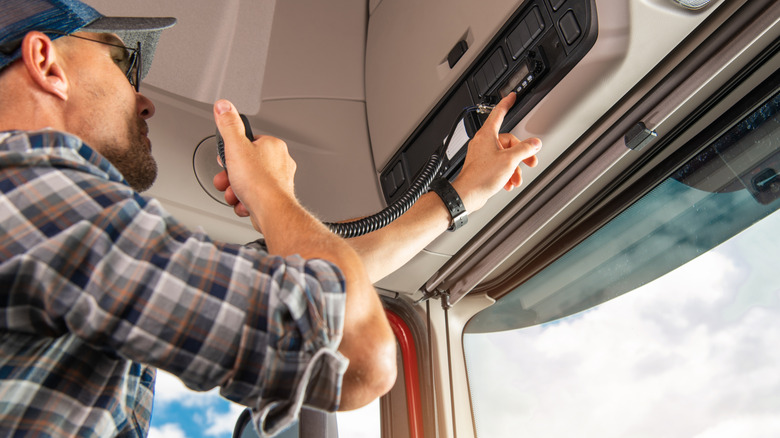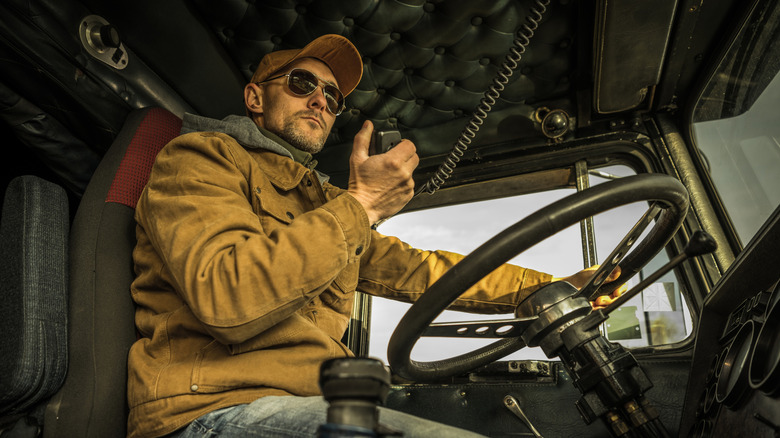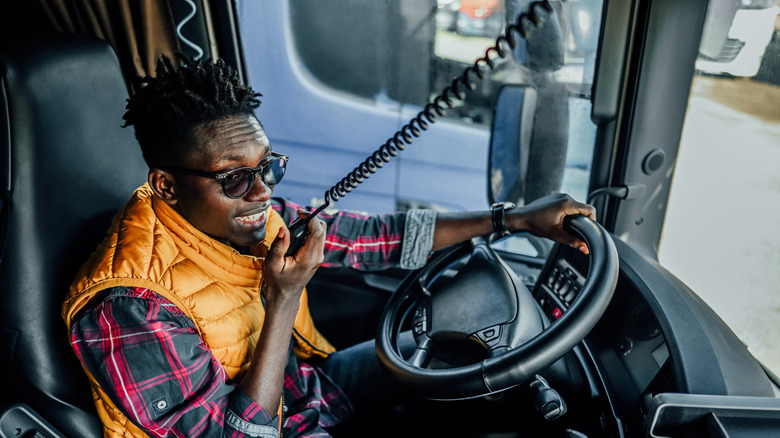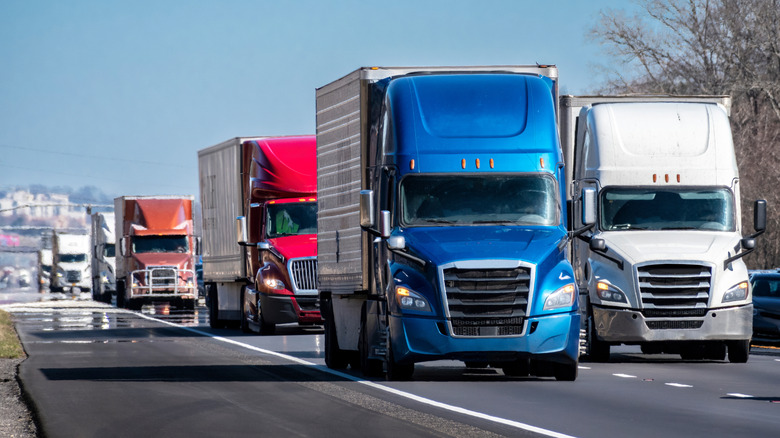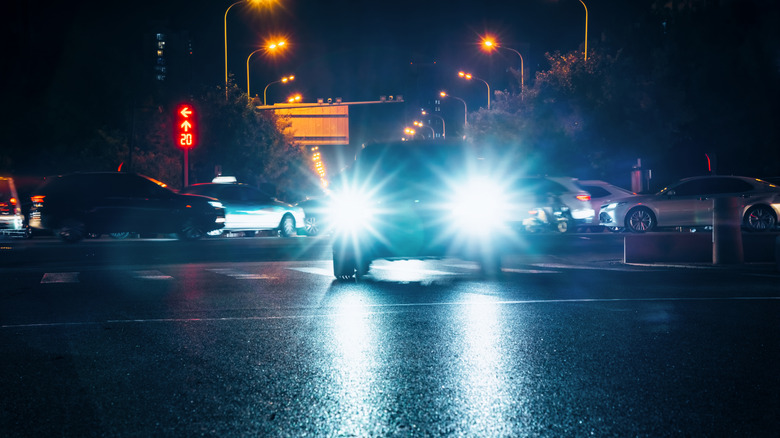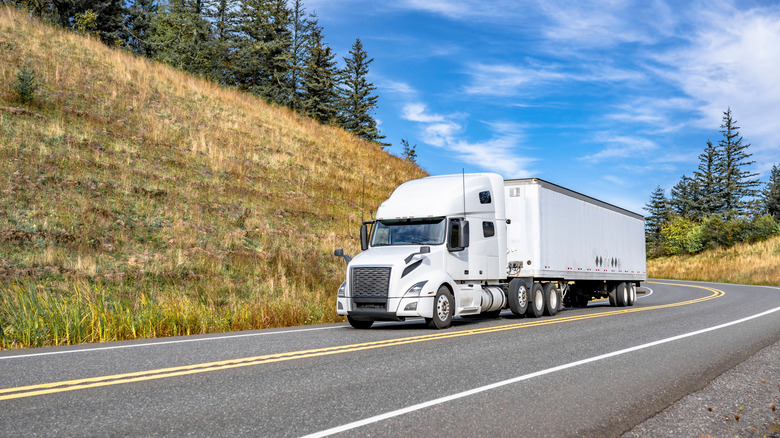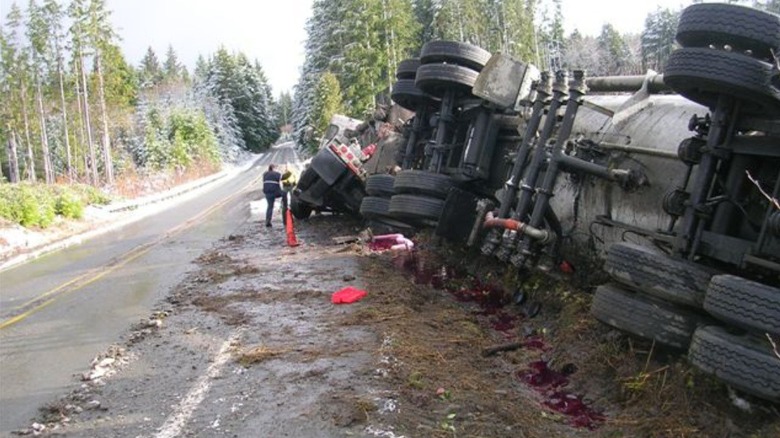Common Trucker Lingo On The CB Radio (And What It Means)
Citizen band radio, more commonly known as CB radio, was first developed in 1945, but took a while to reach the truck-driving masses. By 1958, the FCC had established the first regulations and 23 available channels, later expanded to 40, for CB radio operators.
In a world before cell phones, CB radios offered a welcome means of communication, and even now they remain popular in certain circles. They offer the ability to speak into the void and get an answer back from whomever might be listening. They became popular among truckers who needed a way to communicate with other drivers on the road. They were especially useful during the 1973 oil embargo when truckers used them to communicate about fuel availability, traffic problems, and more.
Subcultures have a way of creating their own lingo. Restaurant line cooks communicate using a language the uninitiated can't understand and CB radio operators are no different. Because you're using shared airwaves, it's considered bad manners to talk too much. Unique slang and 10-codes allow users to communicate information quickly and clearly. In fact, CB radios are so common there's even a term for a truck without one. They call it a Van Gogh, because it has no ears.
Breaker, breaker
One of the benefits of a CB radio is that you can invite strangers to chat. With other modes of communication, you need to know a person's contact information. You need a phone number, an address (email or physical), or a screen name. Then they have to be available to pick up or respond. Saying "breaker, breaker" over a CB radio is the audio equivalent of firing off a flare.
Because radio frequencies are limited, the airwaves are a shared space. When you say something over a CB, you can and will be heard by anyone within range with their radio turned on. You might catch truckers driving down your stretch of the highway or amateur radio operators hanging out at home. And you can share a conversation for as long as you're within range of one another.
"Breaker, breaker" is a general call to get attention, it's shorthand for "hello, anybody out there?" It lets other operators know you're open to chat if they are. It can be followed by a channel number, like, "breaker, breaker one-nine" which means "Hey, does anyone want to chat on channel 19?" You can also add a handle, like, "Breaker, breaker King Kong" if you're looking for someone specific.
Highway gator
In the United States, you can only find actual alligators in Florida, Louisiana, Georgia, Alabama, southern Texas, and parts of North and South Carolina. But you can find "highway gators" pretty much anywhere.
Highway gators are the name given to large pieces of rubber left on the road following a blown tire, the name comes from the resemblance to a gator's back sticking out of the water. When a big truck tire blows you can end up with pieces about 8 feet long, or longer, and they can weigh up to 100 pounds. A hundred pounds of rubber slamming into your vehicle at speed is dangerous — to say nothing of the metal reinforcement wires lodged inside it.
Hitting a highway gator can pop or blow out your own tire, and if they get underneath your vehicle they can cause more significant damage to the undercarriage. They can be more common in warm climates, as heat makes tires more likely to fail. While highway gators are dangerous, owing to their size and weight, smaller pieces of rubber are less dangerous and much cuter, earning them the name "baby gators."
Bears of all varieties
If you hear a trucker on the CB talking about bears, you know there's a police presence nearby. The term probably came from the resemblance between the hats some police officers wear, and the hat Smokey the Bear wears. You'll sometimes hear radio operators refer to the police as "smokeys," but "bear" has become the more commonly used term. In fact, the term is so ubiquitous that it's made its way into commercial products like a radar detectors, with one called the BearTracker.
There are a wide variety of variations designed to specify different sorts of police presences. A "diesel bear" refers to a Department of Transportation (DOT) officer. A speeding vehicle might be called bear bait, and a speeding ticket is a bear bite. If you drive past a police station or law enforcement headquarters, you've driven past a bear cave or a bear den, and a traffic aircraft flying overhead is a bear in the air.
If you see an officer hiding with a radar gun, that's a bear in the bushes. If an officer is looking out for workers in a construction zone, that's a care bear, and an unmarked white police car is a polar bear. Things get even weirder when you start considering situations; if there is a larger than usual police presence on the highway you might say "someone spilled honey on the road." Motorcycle cops are the one major exception without a bear-themed moniker. They are instead referred to as "Evil Knievel."
Ten-codes
When CB radios were first developed and the airwaves were particularly limited, agencies and organizations realized they needed a way to communicate quickly and clearly. Ten-codes were invented in the 1930s by Charles Hooper, a member of the Illinois State Police. They are just one form of what's known as a brevity code, popular among radio operators. Not only did they allow users to communicate quickly and clearly, they also offered the ability to communicate covertly, at least until the code meanings got out.
Eventually, Hooper's ten-codes were formalized and expanded by the Association of Public-Safety Communications Officials-International (APCO). They were standard not just among truck drivers but also among law enforcement officials until 2009. Over time, different jurisdictions started using their own special ten-codes until interdepartmental or interagency communication became impossible, especially during disasters when many different agencies were all working together. Beginning in 2009, many agencies began the switch from using ten-codes to plain language.
The most widely known ten-code is 10-4, which means "message received," it's so widely known that it's bled into common conversation. The code 10-9 means "repeat message," a 10-23 means "standby," and a 10-100 means you need a bathroom break. There are many others, and they've been crucial to communicating on CB radios for decades.
Handle
Horror fans might remember the 2001 film "Joy Ride," starring Paul Walker, Steve Zahn, and Leelee Sobieski. During a road trip, the trio use a dashboard CB radio and the handle "Candycane" to talk with a trucker called Rusty Nail. When a radio prank turns deadly, they have to outrun Rusty Nail's 18-wheeler or die trying.
A handle refers to a CB radio operator's over-the-air nickname, and is used both as a special identifier and as a way to keep yourself anonymous when necessary. As previously mentioned, truckers often call out the presence of police officers, or "bears," and they may not want the cops to know who's talking. Handles have a long history of skirting the law, dating back to the early days of the CB radio when FCC regulations were more stringent.
Because CB radios rely on the open airwaves, aliases were probably inevitable. Today, there are online name generators which will spit out dozens of potential CB handles as quickly as you can refresh the page. In the old days, handles came more honestly, based either on an existing nickname or bestowed upon you by other radio operators. However you settle on your handle, it's a good idea to have one. They've also just become a part of trucking culture, with media like "Smokey and the Bandit" (which features one of the coolest chase scenes in movie history) and the aforementioned "Joy Ride." Handles are a good way to protect personal information over the radio and, more importantly, they're fun.
Bumper sticker
This one is relatively straight forward, referring to a car that is following another vehicle too closely, riding the bumper like they're attached to it. It may refer to a vehicle following any vehicle too closely or specifically to a car that's following you too closely. Tailgating cars are also sometimes called hitchhikers.
People tailgate for a number of reasons. They might be driving in the left lane in a hurry, and want the car in front of them to go faster. They might be mad because someone cut them off, or just an aggressive driver. No matter the reason, tailgating is unsafe. The faster you're traveling down the road, the more space you want between you and other drivers, so everyone's got a chance to react if something unexpected happens.
Tailgating is among the most common unsafe driving behaviors and can lead to serious accidents. That means calling out a "bumper sticker" can be important for safety, especially for truck drivers, because large, heavy trucks have lower response times. It's also sometimes just a way of bonding over the radio by talking trash on other drivers.
Brake check
If you hear a CB operator call out a "brake check," it means there's a traffic jam up ahead. Knowing about traffic congestion in advance is important because large trucks need extra time to fully stop. While a brake check in the real world is dangerous and uncool, a brake check over the radio is a welcome warning. It's considered common courtesy if you encounter a traffic jam to call out a brake check so any other drivers know what's coming down the road.
Stopping distances depend on a number of factors including but not limited to road conditions (it takes longer to slow down on wet or icy roads), the speed you're traveling, and the weight of the vehicle. Other factors include reaction time of the driver and brake lag. Passenger cars use hydraulic brakes which respond almost immediately, but large trucks use air brakes which take a little longer to engage.
The average passenger vehicle weighs roughly 3,000 to 4,000 pounds. A large truck, by contrast, can weigh 80,000 pounds. At freeway speeds, a passenger car takes a little more than 300 feet to come to a stop, on average, while a large truck takes 525 feet. Even during good driving conditions, cargo trucks need more space to slow down and stop. Radio brake checks help to keep the roads safe during unexpected traffic conditions.
Eyeballs
Some slang words and pieces of coded speech need a bit of explaining. They take you on a winding trip from one cultural or linguistic connection to the next until you end up with a seemingly unrelated association. Other times, like in the case of eyeballs, they speak for themselves.
Sometimes, the word "eyeball" is used to say you've seen something on the road, as in "I just eyeballed a polar bear." More broadly, it's used to describe the headlights of a vehicle. Both uses are self-explanatory. Long before the arrival of Pixar's "Cars" and Lightning McQueen, people recognized the resemblance between the front of a vehicle and a face.
The connection between headlights and eyes was especially strong in the late twentieth century when pop-up headlights were popular. Opening and closing them made it look like the car was blinking, and if one of the mechanisms got stuck open (a common problem) it looked like the car was winking. The most common usage of this slang among CB operators is in the form of a "black eye," which refers to a driver with a missing headlight.
Georgia overdrive
When the transmission of an 18-wheeler is engaged, there's a limit to how fast it can travel, even when moving along a steep downhill grade. "Georgia overdrive" refers to any time a driver puts their truck in neutral on a downhill grade.
Truckers often have to travel long distances in relatively short times. Moreover, there are limits to how long a person can drive each day before taking a rest. The precise guidelines vary depending on the industry, but a driver typically can't drive for more than 10-15 hours before taking a mandatory rest period of 8-10 hours. When crossing a country, especially if you're running behind, drivers might be motivated to cover as much ground as quickly as possible. It isn't safe and it isn't legal, but it happens.
Georgia overdrive sometimes refers to saving fuel by putting the truck into neutral and using gravity to carry you on your way without pressing the accelerator, but also without exceeding the recommended speed limit. More often, it refers to a dangerous maneuver in which the driver puts the truck in neutral and lets the truck get up to excessive speeds while traveling downhill. It's one of the reasons there are runaway truck lanes on downhill mountain roads. If the brakes fail there's nothing to stop 80,000 pounds of metal, rubber, and cargo from careening out of control. If you hear someone say they're going into Georgia overdrive, give them some room.
Keep the shiny side up
On a large truck, the top side is colloquially called the shiny side and the bottom is the greasy side. Telling another driver to "keep the shiny side up" is a casual way of telling them to drive safely. Keeping the shiny side up is a good idea whether you're driving an 18-wheeler or the family sedan.
The phrase is part humorous hyperbole and part actually warning. Because of the comparatively tall and slender profile and the impressive weights involved, loaded 18-wheelers are at actual risk of tipping over if not driven correctly. The risk of tipping can increase if a truck is improperly loaded. When moving tens of thousands of pounds down the road, it's important to move carefully.
There are plenty of dangers on the road, from the fatigue of driving for 10 hours or more to poor road conditions, other drivers, and more. All of that has to be taken into account if you want yourself and your load to get where you're going, on time and in one piece.
Being a trucker can be a solitary existence, with long stretches in the driver's seat, watching the road roll away behind you. You rarely stay in one place and you're always in transit. Home is the highway. But there's a community on the radio of likeminded folks living similar lifestyles, and the CB radio can expand your ability to communicate with them on the road beyond a trucker salute.
